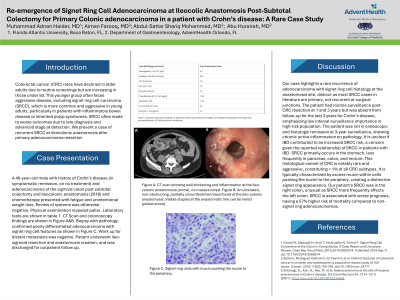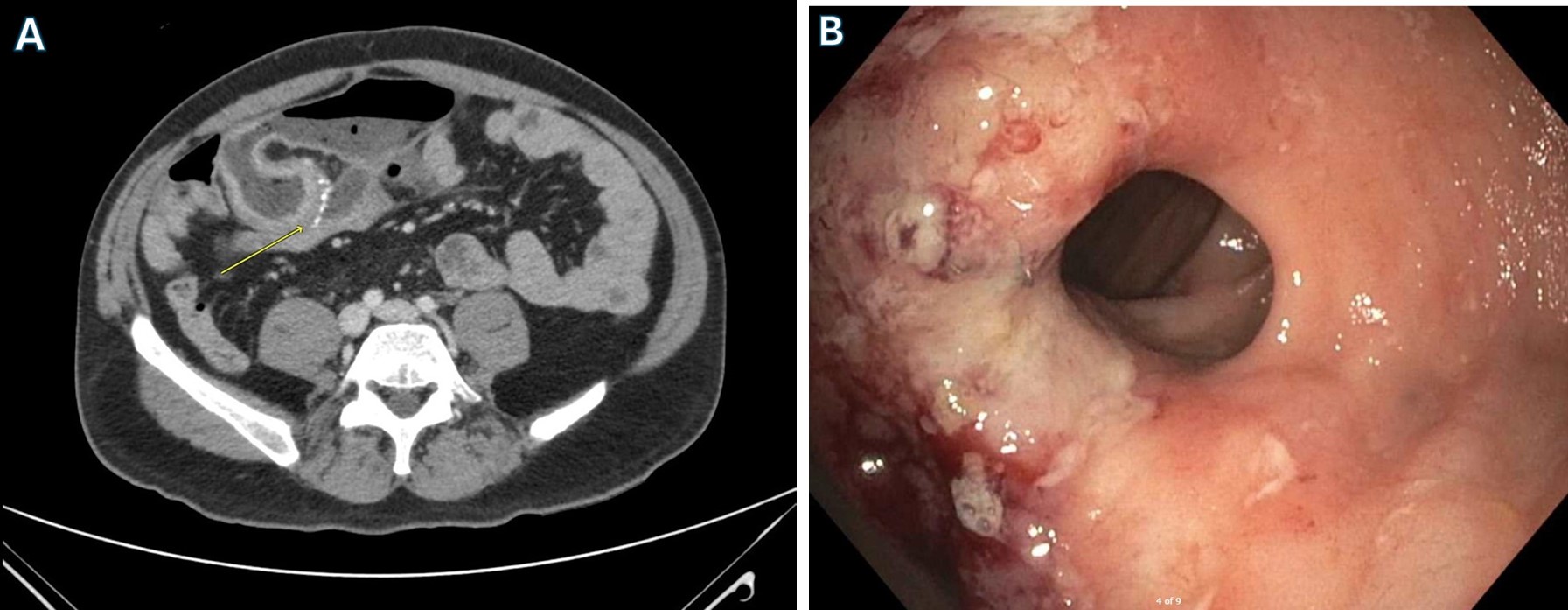Monday Poster Session
Category: Colon
P2078 - Re-Emergence of Signet Ring Cell Adenocarcinoma at Ileocolic Anastomosis Post-Subtotal Colectomy for Primary Colonic Adenocarcinoma in a Patient With Crohn’s Disease: A Rare Case Study
Monday, October 28, 2024
10:30 AM - 4:00 PM ET
Location: Exhibit Hall E

Has Audio

Muhammad Adnan Haider, MD
Florida Atlantic University
Boca Raton, FL
Presenting Author(s)
Muhammad Adnan Haider, MD1, Aimen Farooq, MD2, Abdul-Sattar Shariq Mohammed, MD2, Abu Hurairah, MD3
1Florida Atlantic University, Boca Raton, FL; 2AdventHealth, Orlando, FL; 3AdventHealth Medical Group, AdventHealth, Orlando, FL
Introduction: Colorectal cancer (CRC) rates have declined in older adults due to routine screenings, but are increasing in those under 50. This younger group often faces aggressive disease, including signet ring cell carcinoma (SRCC), which is more common and aggressive in young adults, particularly in patients with inflammatory bowel disease or inherited polyp syndromes. SRCC often leads to worse outcomes due to late diagnosis and advanced stage at detection. We present a case of recurrent SRCC at ileocolonic anastomosis after primary adenocarcinoma resection.
Case Description/Methods: A 46-year-old male with history of Crohn’s disease (in symptomatic remission, on no treatment) and adenocarcinoma of the sigmoid colon post subtotal colectomy and ileocolonic anastomosis (2016) and chemotherapy presented with fatigue and unintentional weight loss. Review of systems was otherwise negative. Physical examination revealed pallor. Laboratory tests are shown in table 1. CT Scan and colonoscopy findings are shown in Figure A&B. Biopsy confirmed poorly differentiated adenocarcinoma with signet ring cell features. Work up for distant metastasis was negative. Patient underwent ileo-sigmoid resection and anastomosis creation, and was discharged for outpatient follow up.
Discussion: Our case highlights a rare recurrence of adenocarcinoma with signet ring cell histology at the anastomosis site, distinct as most SRCC cases in literature are primary, not recurrent at surgical junctions. The patient had routine surveillance post-CRC resection at 1 and 3 years but was absent from follow-up for the last 3 years for Crohn’s disease, emphasizing low interval surveillance importance in high-risk population. The patient was not in endoscopic and histologic remission at 3-year surveillance, showing chronic active inflammation on pathology. It is unclear if IBD contributed to an increased SRCC risk, a concern given the reported relationship of SRCC in patients with IBD.
SRCC primarily occurs in the stomach, less frequently in pancreas, colon, and rectum. This histological variant of CRC is notably rare and aggressive, constituting < 1% of all CRC subtypes. It is typically characterized by excess mucin within cells pushing the nuclei to the periphery, creating a distinctive signet ring appearance. Our patient's SRCC was in the right colon, unusual as SRCC more frequently affects the left colon. SRCC is associated with worse prognosis, having a 57% higher risk of mortality compared to non-signet ring adenocarcinomas.

Note: The table for this abstract can be viewed in the ePoster Gallery section of the ACG 2024 ePoster Site or in The American Journal of Gastroenterology's abstract supplement issue, both of which will be available starting October 27, 2024.
Disclosures:
Muhammad Adnan Haider, MD1, Aimen Farooq, MD2, Abdul-Sattar Shariq Mohammed, MD2, Abu Hurairah, MD3. P2078 - Re-Emergence of Signet Ring Cell Adenocarcinoma at Ileocolic Anastomosis Post-Subtotal Colectomy for Primary Colonic Adenocarcinoma in a Patient With Crohn’s Disease: A Rare Case Study, ACG 2024 Annual Scientific Meeting Abstracts. Philadelphia, PA: American College of Gastroenterology.
1Florida Atlantic University, Boca Raton, FL; 2AdventHealth, Orlando, FL; 3AdventHealth Medical Group, AdventHealth, Orlando, FL
Introduction: Colorectal cancer (CRC) rates have declined in older adults due to routine screenings, but are increasing in those under 50. This younger group often faces aggressive disease, including signet ring cell carcinoma (SRCC), which is more common and aggressive in young adults, particularly in patients with inflammatory bowel disease or inherited polyp syndromes. SRCC often leads to worse outcomes due to late diagnosis and advanced stage at detection. We present a case of recurrent SRCC at ileocolonic anastomosis after primary adenocarcinoma resection.
Case Description/Methods: A 46-year-old male with history of Crohn’s disease (in symptomatic remission, on no treatment) and adenocarcinoma of the sigmoid colon post subtotal colectomy and ileocolonic anastomosis (2016) and chemotherapy presented with fatigue and unintentional weight loss. Review of systems was otherwise negative. Physical examination revealed pallor. Laboratory tests are shown in table 1. CT Scan and colonoscopy findings are shown in Figure A&B. Biopsy confirmed poorly differentiated adenocarcinoma with signet ring cell features. Work up for distant metastasis was negative. Patient underwent ileo-sigmoid resection and anastomosis creation, and was discharged for outpatient follow up.
Discussion: Our case highlights a rare recurrence of adenocarcinoma with signet ring cell histology at the anastomosis site, distinct as most SRCC cases in literature are primary, not recurrent at surgical junctions. The patient had routine surveillance post-CRC resection at 1 and 3 years but was absent from follow-up for the last 3 years for Crohn’s disease, emphasizing low interval surveillance importance in high-risk population. The patient was not in endoscopic and histologic remission at 3-year surveillance, showing chronic active inflammation on pathology. It is unclear if IBD contributed to an increased SRCC risk, a concern given the reported relationship of SRCC in patients with IBD.
SRCC primarily occurs in the stomach, less frequently in pancreas, colon, and rectum. This histological variant of CRC is notably rare and aggressive, constituting < 1% of all CRC subtypes. It is typically characterized by excess mucin within cells pushing the nuclei to the periphery, creating a distinctive signet ring appearance. Our patient's SRCC was in the right colon, unusual as SRCC more frequently affects the left colon. SRCC is associated with worse prognosis, having a 57% higher risk of mortality compared to non-signet ring adenocarcinomas.

Figure: Figure A: CT scan showing wall thickening and inflammation at the ileo-colonic anastomosis (arrow), no masses noted.
Figure B: An ulcerated, non-obstructing, partially circumferential mass found at the ileo-colonic anastomosis. Visible staples at the anastomotic line can be noted (yellow arrow).
Figure B: An ulcerated, non-obstructing, partially circumferential mass found at the ileo-colonic anastomosis. Visible staples at the anastomotic line can be noted (yellow arrow).
Note: The table for this abstract can be viewed in the ePoster Gallery section of the ACG 2024 ePoster Site or in The American Journal of Gastroenterology's abstract supplement issue, both of which will be available starting October 27, 2024.
Disclosures:
Muhammad Adnan Haider indicated no relevant financial relationships.
Aimen Farooq indicated no relevant financial relationships.
Abdul-Sattar Shariq Mohammed indicated no relevant financial relationships.
Abu Hurairah indicated no relevant financial relationships.
Muhammad Adnan Haider, MD1, Aimen Farooq, MD2, Abdul-Sattar Shariq Mohammed, MD2, Abu Hurairah, MD3. P2078 - Re-Emergence of Signet Ring Cell Adenocarcinoma at Ileocolic Anastomosis Post-Subtotal Colectomy for Primary Colonic Adenocarcinoma in a Patient With Crohn’s Disease: A Rare Case Study, ACG 2024 Annual Scientific Meeting Abstracts. Philadelphia, PA: American College of Gastroenterology.
